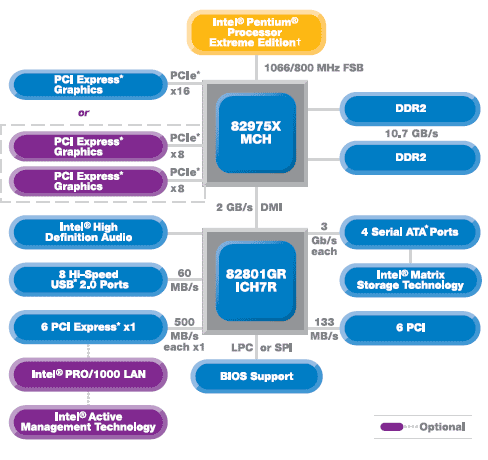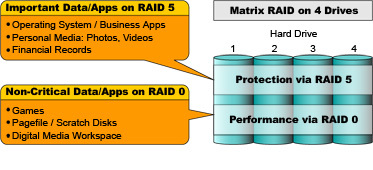Intel or Nvidia? nForce 680i Challenges Intel P965 and 975X
Intel 975X Express Chipset
The 975X is Intel's third-generation PCI Express core logic for enthusiasts, following the 925X/XE and the 955X. It supports all Intel processors, whether you want to use a Celeron, Pentium 4, Core 2 Duo or Core 2 Quad, including the corresponding Extreme Editions, and it thus supports all current front side bus speeds between 133 and 266 MHz (FSB533 to FSB1066). Although Intel plans to speed up the bus to 333 MHz (FSB1333) next year, current silicon doesn't officially support this.
All available motherboards support the specified DDR2-667 memory (unbuffered, non-ECC), but Intel also provides the multipliers necessary to run the memory at faster speeds. Consequently, most enthusiast boards also allow switching to DDR2-800 speed at your own risk.
Flex Memory
Most motherboards support four 240-pin DDR2 memory modules with a maximum capacity of 2 GB each, which results in a total main memory capacity of 8 GB. Intel uses its Memory Pipeline technology, which is said to achieve a higher utilization of the memory subsystem.
All current chipsets operate the memory in dual-channel mode, distributing data across two memory channels to double the effective bandwidth. To take advantage of this, you should always equip two or four memory modules rather than an odd number. Intel chipsets also support asymmetrical dual channel mode, allowing the user to pair DIMMs of different capacities (called Intel FlexMemory).
Crossfire Dual Graphics
The 975X comes with a total of 16 PCI Express lanes, plus six additional links for expansion cards. The 16 primary links can be used for a single x16 PCIe slot for graphics, or they can be split into two physical x16 slots utilizing eight lanes each. This is a popular setup for almost all 975X motherboards, as it allows the user to deploy a dual graphics setup based on ATI Radeon X1000 series cards configured in Crossfire dual graphics mode.
Get Tom's Hardware's best news and in-depth reviews, straight to your inbox.
HD Audio And Networking
The ICH7 southbridge has a built-in High Definition Audio controller with 7.1 surround sound support and 192 kHz 32-bit audio quality. All current 975X motherboards come with a Gigabit Ethernet controller, which can be provided by Intel or 3rd party vendors, and is attached via one PCI Express lane.
Matrix Storage Technology
The 975X is paired with the ICH7-R southbridge, offering one UltraATA/100 channel for optical drives and older hard drives, and four Serial ATA II ports with 300 MB/s bandwidth, supporting Native Command Queuing (NCQ). NCQ allows the hard drive to analyze incoming commands and reorganize them, so it can execute them in an order that requires the fewest head movements. The controller is compliant with the Advanced Host Controller Interface (AHCI), which allows for SATA hot plugging. Intel also offers support for RAID levels 0, 1, 0+1 and 5. This is summarized as Matrix Storage Technology, which represents the controller's ability to operate multiple RAID arrays across the same set of physical hard drives.
If you use two hard drives you can setup a RAID 0 or RAID 1 array - or even both. The given example is based on as many as five hard drives, using all of them to run a redundant RAID 5 and an additional RAID 0 as a high performance temporary storage workspace. Should one of the drives fail, your RAID 0 data will be lost, but the RAID 5 will remain degraded, but intact. You can now replace the faulty hard drive and trigger the RAID 5 rebuild process. Image source: Intel website.
You can find more information on the 975X chipset on the Intel website
Current page: Intel 975X Express Chipset
Prev Page PC Essentials: What To Buy? Next Page MSI 975X Platinum Powerup Edition
Patrick Schmid was the editor-in-chief for Tom's Hardware from 2005 to 2006. He wrote numerous articles on a wide range of hardware topics, including storage, CPUs, and system builds.

